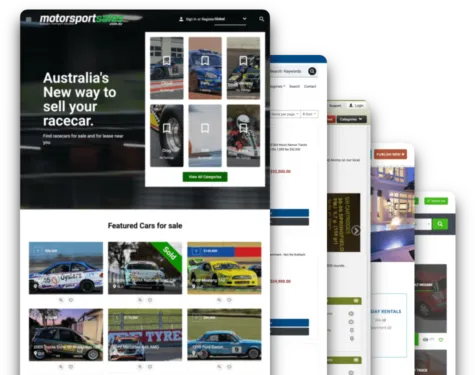Building a marketplace is no small feat.
A seamless User Interface (UI) and User Experience (UX) design are crucial to retaining users.

Yet, many marketplace developers fall into common design traps.
This guide explores frequent UI/UX mistakes and strategies to overcome them, enhancing the overall marketplace experience.
The Importance of UI/UX in Marketplaces
Marketplaces thrive on user engagement and trust.
A well-designed UI fosters intuitiveness, while UX ensures functionality and user satisfaction.
Neglecting these aspects can lead to poor performance, high bounce rates, and reduced conversions.
Key Statistics
- 88% of online users are less likely to return to a website after a bad experience (Toptal).
- 70% of e-commerce site failures are due to poor usability (UXCam).

1. Overcomplicated Interfaces: Less Is More
Challenge:
Many marketplaces overload their interfaces with unnecessary elements, creating confusion.
Solution:
- Minimalistic Design: Prioritize essential functions, using white space effectively.
- Streamlined Navigation: Implement intuitive menus and breadcrumbs for easy browsing.
- Responsive Design: Ensure usability across devices, catering to mobile-first audiences.
Case Study: Etsy
Etsy keeps its interface clean by highlighting product images and using straightforward navigation. This simplicity contributes to high user retention.

2. Neglecting Mobile Optimization
Challenge:
With mobile commerce accounting for over 72.9% of global e-commerce sales, ignoring mobile design is a critical mistake (Statista).
Solution:
- Mobile-First Design: Develop the mobile version before scaling to desktop.
- Fast Loading Speed: Compress images and use adaptive designs to enhance performance.
- Clickable Elements: Use large, tappable buttons and adequate spacing for a touch-friendly interface.
Case Study: Airbnb
Airbnb’s mobile app offers a flawless experience with large visuals, simple search filters, and easy navigation. This focus on mobile optimization drives bookings.
3. Ignoring User Feedback and Testing
Challenge:
Designers often overlook end-user input, leading to misaligned features.
Solution:
- User Surveys and Interviews: Gather insights directly from users about pain points.
- A/B Testing: Experiment with different design elements to see what resonates best.
- Heatmaps: Use tools like Hotjar to track user behavior and identify friction points.
Case Study: Amazon
Amazon continuously tests UI/UX elements, leading to features like one-click checkout, significantly improving the shopping experience.
4. Poor Search Functionality and Filters
Challenge:
Inefficient search tools frustrate users, leading to abandoned sessions.
Solution:
- Autocomplete Suggestions: Save time by predicting user queries.
- Robust Filters: Allow filtering by price, category, ratings, and more.
- Search Analytics: Monitor search trends and optimize results accordingly.
Data:
43% of users go directly to the search bar when visiting a marketplace (Baymard Institute).
Case Study: eBay
eBay’s search engine efficiently connects users with relevant products, integrating advanced filters and AI-driven suggestions.
5. Cluttered Product Listings
Challenge:
Messy layouts and inconsistent information deter potential buyers.
Solution:
- Standardized Formats: Ensure uniform product titles, descriptions, and images.
- High-Quality Visuals: Use professional-grade photos to attract buyers.
- Detailed Descriptions: Include dimensions, features, and benefits concisely.
Case Study: Zalando
Zalando excels in product presentation by offering high-resolution images, videos, and comprehensive details, increasing buyer trust.
6. Failing to Build Trust Through Design
Challenge:
Users are wary of sharing personal and financial details on untrustworthy platforms.
Solution:
- Secure Payment Options: Display security badges and SSL certificates.
- Transparent Policies: Highlight return, refund, and privacy policies prominently.
- User Reviews: Allow verified reviews to build credibility.
Data:
75% of users judge a site’s credibility based on its design (Stanford University).
Case Study: Fiverr
Fiverr builds trust through verified reviews, secure payment gateways, and clear communication channels, ensuring user satisfaction.
7. Underestimating Onboarding and Accessibility
Challenge:
Complicated sign-up processes and inaccessible designs exclude potential users.
Solution:
- Simplified Onboarding: Use social logins or email sign-ups with minimal steps.
- Accessibility Features: Implement screen reader compatibility, alt text, and keyboard navigation.
- Tutorials and Guides: Offer interactive walkthroughs for new users.
Case Study: Shopify
Shopify’s onboarding includes guided steps for setting up stores, making it beginner-friendly.
Challenges and Solutions in UI/UX
| Challenge | Solution |
|---|---|
| Overcrowded Interfaces | Minimalistic design, focusing on essential features. |
| Slow Loading Times | Optimize media, use caching, and adopt a content delivery network (CDN). |
| Lack of User Trust | Secure design elements like HTTPS, clear privacy policies, and visible reviews. |
| Accessibility Barriers | Comply with WCAG guidelines to create an inclusive experience. |
Future Innovations and Evolving Strategies
- AI-Powered Personalization: AI will predict user preferences, offering tailored suggestions and dynamic layouts. Example: Amazon's recommendation engine boosts conversions by 35%.
- Voice Search Integration: Voice-enabled navigation will become standard, simplifying searches.
- Immersive Technologies: AR/VR can revolutionize how users experience products in marketplaces. Example: IKEA Place app lets users visualize furniture in their homes.
- Blockchain for Transparency: Decentralized systems will enhance trust with secure, verifiable transactions.
Conclusion
UI/UX mistakes can significantly hinder marketplace growth.
By addressing common pitfalls like overcomplicated designs, poor mobile optimization, and neglecting user feedback, marketplaces can deliver exceptional experiences.
Embrace innovations like AI and AR to stay competitive.
Looking to Create a Marketplace? Contact Us at Yclas.

